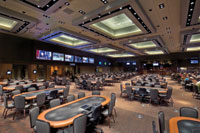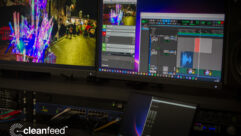

Working Together
Feb 2, 2011 11:07 AM,
by Dan Daley
CCS Presentation Systems provides traditional and modern solutions for Talking Stick Resort and Casino.
The videowall at Talking Stick Resort and Casino is comprised of six Panasonic TH-103PF9UK HD 103in. plasmas. Forty sources feed content to the screens regularly.
Getting the job is often the single biggest strategic matter of any project, and systems integrator CCS Presentation Systems devised a very good one to land the systems design/build portion of the new Talking Stick Resorts and Casino, which opened on the Salt River Pima Native American reservation in Scottsdale, Ariz. When the tribe’s other casino project, Casino Arizona at Salt River, needed technical refurbishment and ongoing maintenance in 2008, CCS bid for and won that job. In addition to bringing that new casino’s audio and video systems up to date and setting up a maintenance regimen, the company was also displaying its capabilities and nurturing relationships for the tribe’s planned new resort hotel and casino.
“It was still a bid project, so we knew we had competitors,” says Rod Andrewson, manager of engineering for CCS, who says the strategy was hatched jointly by CCS sales, marketing, and technical management departments. “But they knew us, and they knew what we were capable of by that time. If it came down to two companies being very close in their bids, this is the thing that can put it over. And, happily, it did.”
Talking Stick Resort and Casino is sprawling, with 497 guest rooms for patrons of its 240,000-plus square foot casino, home to 900 slot machines and one of the largest professional poker tables in the U.S., as well as a 750-seat performance theater and a 13,000-square-foot spa on the 14th floor of the 15-story hotel. The 50,000-square-foot conference facility can be divided into 22 meeting rooms, with another 50,000 square feet of adjacent outdoor patio space that can become part of the conference/event facility, benefiting from Arizona’s relentlessly brilliant weather. The conference center is linked to the hotel and casino’s master control room, which updates the digital signage outside of each meeting room as conference agendas change. Interestingly, the systems for each of the meeting spaces rely on more traditional house-tech-operated projectors and screens, which Andrewson says was the client’s decision. There are 38 individual zones of audio for the entire conference center, including its patio. The zones are managed by the Neon system and linked to the main CobraNet network backbone of the main facility. There is also a separate DMX background music system with an AMX NI-700 touchpanel control in each room.
VideoWall
The casino needed a signature technology proposition, and CCS devised one in the form of a videowall comprised of six Panasonic TH-103PF9UK HD 103in. plasma displays along one wall of the room, which displays entertainment and information coming from 40 sources throughout the facility including 20 satellite tuners, five custom-made gaming-specific content sources and two Plantronic digital signage players, two Vaddio HD ceiling-mounted document cameras over the main poker tournament table and in the conference center, and one Vaddio WallView CCU H700 CCU H700 PTZ camera in the show theater. Sources—and just about everything else—are controlled from a master control room housed within the back-of-house AV headend, built around a 64×144 Magenta Research Mondo Matrix 30-frame Cat-5 switcher and Peavey Nion audio processing systems, with two smaller headends in the conference center and the hotel tower. The master control is in charge of digital signage throughout the complex, as well as controlling an 8-channel DMX background music system, all security cameras, and the facility-wide paging system.

CCS had to work closely with the casino’s IT infrastructure provider to pull cable for the installation. While the installation required Cat-5 runs as long as 2000ft., CCS used the IT infrastructure for the large CobraNet audio distribution system.
But that huge videowall required some serious thinking when it came to deciding how to mount it. “The first concept had been to hang the displays from the wall, but the wall was simply not engineered to withstand the weight of six 550lbs. video monitors, plus all their mounting hardware and cabling,” Andrewson says. However, it was determined that the architectural I-beams could sustain that weight. The displays are suspended from them using custom-made lifts that use 1-ton winch motors to raise them and keep them in place. While the initial investment in a custom lift system was expensive, the cost benefit of doing so for ease of maintenance or replacement ultimately outweighed the alternative of temporarily closing down a room that operates 24/7. “The displays can be lowered one panel at a time on a custom lift system that was created specifically for the client,” he says. In fact, 14 more of the same Panasonic displays will be hung on surrounding walls in the same manner.
AV Meets IT
Talking Stick is a good example of the ongoing convergence between AV and IT. CCS gave the casino’s IT infrastructure provider a detailed cable pull list, but how those two camps use cabling underscores the difference between AV and IT. “It was difficult for them to understand that our video would be distributed over Cat-5 cable and was not intended to be built out to network cabling standards,” Andrewson explains. “Some of the runs approach 2,000ft. over Cat-5, using the Magenta Mondo Matrix to push video over those cables. They would have intuitively pushed it over standard 300-meter network backbone [cabling]. We also didn’t use common IDF rooms, so we could pass through our patch panels and combined control systems network, sending the AMX [NI-3100] NetLinx controller we’re using over Ethernet. We’re also using a very large CobraNet distribution system that we have to provide for over [the IT] infrastructure, so they had to partition us off our own VLAN amongst their switches as well as a control VLAN for our touchpanels and controllers in those same IDFs. It really required us to work as one unit.”
All told, the systems side required 75,000ft. of cabling, most of it Cat-5, and there are 390 channels of audio on the CobraNet network and 75 networked control devices that reside on their own separate VLAN.
Working Together
Feb 2, 2011 11:07 AM,
by Dan Daley
CCS Presentation Systems provides traditional and modern solutions for Talking Stick Resort and Casino.

The distributed audio system’s sound level management is based around sophisticated programming based on the casino’s foot traffic. CCS used the casino’s various data collections, such as guest cards scanned at slot machines, to design a automated level-sensing system to fit the casino’s needs.
Sounds Good
The casino, conference center, pool areas, restaurants, lounges, and lobbies are all on the same sound distribution system and are controlled from the master control room. Up on the 14th floor, the spas give their patrons control of the audio coming from JBL Control series speakers (mostly Control 26 in-ceiling speakers and Control 19 subs) that are installed in each room. Each treatment suite has the ability to select from three sound sources and can vary the volume on demand. All rooms, including the fitness center and reception area, can be alternately managed by the reception desk from a main control panel.
Audio distribution for Talking Stick is based on a unique premise: “There are over 1,000 speakers all over the property, inside and out, and we needed a way to adjust their volume level for each area and at various times of the day,” Andrewson explains. “The decision was between using an automated level-sensing system that detected the ambient noise in each area and adjusted the local volume accordingly or go with a preprogrammed system that had set level rules for various times and locations.”
The automated level-sensing solution appeared initially attractive since it required little hands on from managers. However, further research revealed that in certain areas of the casino, specifically the slot floor, the ambient noise levels could change quickly and fluctuate dramatically at any given moment, depending on the crowd traffic flows. But on its face, the preprogrammed rules approach seemed clumsy and inflexible, Andrewson says. “The client had actually tried using automatic level-sensing systems in the past in the other casino, but they were very rudimentary, sometimes with literally two settings—one high and one low—so they had abandoned them. But then, the light bulb over our head went on,” he says.
Andrewson and his teammates, Senior Engineer John Steineke and Project Manager Mike Abb, learned that the casino management was borderline obsessive about data collection at their properties. “They have very, very detailed attendance data that goes back extensively,” Andrewson says. “They had records of what [foot] traffic was like in every area of the hotel and casino at every hour of the day and night for every day of the week using software tools like guest cards in slot machines that leave a kind of fingerprint of the traffic flow pattern. They were using this data to forecast revenues and predict staffing needs, but we realized that this data matrix was what we needed to do some sophisticated programming of the distributed audio system’s level management.”
In some areas, AMX control panels were installed to give local managers the ability to adjust local volume levels as needed. In other areas, the hotel’s data allowed them to program predicted changes. “We could translate that into patterns that let us be very precise and very accurate of what the SPL needs of a given part of the hotel would be on a given day and time,” Andrewson explains. “We could predict where there would be minimal level changes during a 24-hour period, like the parking garages, where the level might vary between 3dB to 6dB all day long. We programmed the Peavey Nion n3 chassis to make the adjustments accordingly. [It] was amazing how precise we could get using that information they made available to us.”
There was a lot of new thinking going on at the Talking Stick hotel, from strategizing to getting the project to finding cost-effective and efficient ways of making it work. Andrewson says being in at the very beginning of a design/build proposition was critical to making that work. “Having everyone there at the start, everyone involved including us, the GC, the subs, made a huge difference,” he says. “They committed to getting AV involved as early as possible and that brought everyone significant value. It changes everything, including the behavior of other trades and contractors when they see what a difference having everyone on the same page at the very beginning can make. It was a good lesson for everyone.”










